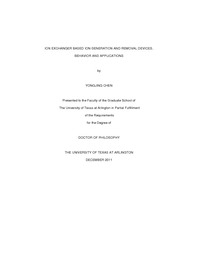
ATTENTION: The works hosted here are being migrated to a new repository that will consolidate resources, improve discoverability, and better show UTA's research impact on the global community. We will update authors as the migration progresses. Please see MavMatrix for more information.
Show simple item record
| dc.contributor.author | Chen, Yongjing | en_US |
| dc.date.accessioned | 2012-04-11T20:54:55Z | |
| dc.date.available | 2012-04-11T20:54:55Z | |
| dc.date.issued | 2012-04-11 | |
| dc.date.submitted | January 2011 | en_US |
| dc.identifier.other | DISS-11381 | en_US |
| dc.identifier.uri | http://hdl.handle.net/10106/9536 | |
| dc.description.abstract | Ion exchangers have many important applications. In Ion chromatography (IC), ion exchangers are used as stationary phase and used in some of the key components. The innovations that make the modern IC the most popular techniques for ion analysis are closely related to ion exchangers. Using the ion exchangers and inspired by some of the innovations in electrolytic devices of IC, the research in this dissertation mainly consists of four parts: A charge detector (ChD) is a flow-through device where a cation exchange membrane (CEM) and anion exchange membrane (AEM) separating three channels. One electrode is disposed in each of the outer channels. A constant electric field is applied to the electrodes with the one on CEM side is positive relative to the one on AEM side, and the current is monitored. Any injected ions in the water carrier passing through the device produce a current signal that is directly related to the charge the ions carry, regardless of their electrochemical properties. The ChD provides a new technique for measurement of ionic solutes in solution phase. Essentially ChD is a "deionizer", which removes ions from the central channel into the outer channels. Based on the same principle, a capillary-scale salt remover (SR) was developed to desalt the proteins prior to their entering into ESI-MS. The SR effectively removes salt ions but not the proteins, which have poorer electrophoretic mobility relative to the salts, guaranteeing the good quality of ESI-MS spectra of the salt-free proteins. Three common proteins were tested, and > 99.8% salt removal in 154 mM NaCl continuous flow at 1 ìL/min with > 80% of concurrently present 20 ìM proteins transmission was achieved. The Self-Regenerating Suppressors (SRS) in IC were first time demonstrated to be used as electrodialytical buffer generator (EBG). Buffers of constant concentration but variable pH can be generated by feeding the salts of weak acids or salts of weak bases into the central channels of Anion Self-Regenerating Suppressor (ASRS) and Cation Self-Regenerating Suppressor (CSRS). Linear pH gradients with excellent linearity and reproducibility are produced by feeding the buffer reagent mixture and varying the current applied to the device. A three-electrode EBG was developed in a configuration similar to ChD, except that a electrode is introduced into the central channel to constitute the ground while the electrode in CEM side outer channel is positive and the electrode in AEM side outer channel is negative. With chosen feed in the outer channels, the device is operated in "additive mode", where buffers of variable composition can be generated in the central channel with both controllable concentration and pH. When the polarity is reversed, the device can be operated in a "subtractive mode", where buffer components are removed from the central channel. The device can be operated in a mixed mode which incorporates both additive and subtractive mode, providing a better versatility of generating buffer pH gradients. | en_US |
| dc.description.sponsorship | Dasgupta, Purnendu K. | en_US |
| dc.language.iso | en | en_US |
| dc.publisher | Chemistry & Biochemistry | en_US |
| dc.title | Ion Exchanger Based Ion Generation And Removal Devices. Behavior And Applications | en_US |
| dc.type | Ph.D. | en_US |
| dc.contributor.committeeChair | Dasgupta, Purnendu K. | en_US |
| dc.degree.department | Chemistry & Biochemistry | en_US |
| dc.degree.discipline | Chemistry & Biochemistry | en_US |
| dc.degree.grantor | University of Texas at Arlington | en_US |
| dc.degree.level | doctoral | en_US |
| dc.degree.name | Ph.D. | en_US |
Files in this item
- Name:
- Chen_uta_2502D_11381.pdf
- Size:
- 8.409Mb
- Format:
- PDF
This item appears in the following Collection(s)
Show simple item record


